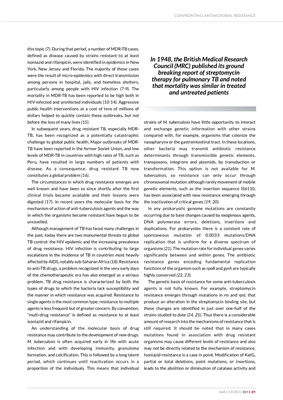
this topic (7). During that period, a number of MDR-TB cases,
defined as disease caused by strains resistant to at least
isoniazid and rifampicin, were identified in epidemics in New
York, New Jersey and Florida. The majority of these cases
were the result of micro-epidemics with direct transmission
among persons in hospital, jails, and homeless shelters,
particularly among people with HIV infection (7-9). The
mortality in MDR-TB has been reported to be high both in
HIV-infected and uninfected individuals (10-14). Aggressive
public health interventions at a cost of tens of millions of
dollars helped to quickly contain these outbreaks, but not
before the loss of many lives (15).
In subsequent years, drug resistant TB, especially MDRTB,
has been recognized as a potentially catastrophic
challenge to global public health. Major outbreaks of MDRTB
have been reported in the former Soviet Union, and low
levels of MDR-TB in countries with high rates of TB, such as
Peru, have resulted in large numbers of patients with
disease. As a consequence, drug resistant TB now
constitutes a global problem (16).
The circumstances in which drug resistance emerges are
well known and have been so since shortly after the first
clinical trials became available and their lessons were
digested (17). In recent years the molecular basis for the
mechanism of action of anti-tuberculosis agents and the way
in which the organisms become resistant have begun to be
unravelled.
Although management of TB has faced many challenges in
the past, today there are two monumental threats to global
TB control: the HIV epidemic and the increasing prevalence
of drug resistance. HIV infection is contributing to large
escalations in the incidence of TB in countries most heavily
affected by AIDS, notably sub-Saharan Africa (18). Resistance
to anti-TB drugs, a problem recognized in the very early days
of the chemotherapeutic era has also emerged as a serious
problem. TB drug resistance is characterized by both the
types of drugs to which the bacteria lack susceptibility and
the manner in which resistance was acquired. Resistance to
single agents is the most common type; resistance to multiple
agents is less frequent but of greater concern. By convention,
"multi-drug resistance" is defined as resistance to at least
isoniazid and rifampicin.
An understanding of the molecular basis of drug
resistance may contribute to the development of new drugs.
M. tuberculosis is often acquired early in life with acute
infection and with developing immunity, granuloma
formation, and calcification. This is followed by a long latent
period, which continues until reactivation occurs in a
proportion of the individuals. This means that individual
strains of M. tuberculosis have little opportunity to interact
and exchange genetic information with other strains
compared with, for example, organisms that colonize the
nasopharynx or the gastrointestinal tract. In these locations,
other bacteria may transmit antibiotic resistance
determinants through transmissible genetic elements,
transposons, integrons and plasmids, by transduction or
transformation. This option is not available for M.
tuberculosis, so resistance can only occur through
chromosomal mutation although rarely movement of mobile
genetic elements, such as the insertion sequence IS6110,
has been associated with new resistance emerging through
the inactivation of critical genes (19, 20).
In any prokaryotic genome mutations are constantly
occurring due to base changes caused by exogenous agents,
DNA polymerase errors, deletions, insertions and
duplications. For prokaryotes there is a constant rate of
spontaneous mutation of 0.0033 mutations/DNA
replication that is uniform for a diverse spectrum of
organisms (21). The mutation rate for individual genes varies
significantly between and within genes. The antibiotic
resistance genes encoding fundamental replication
functions of the organism such as rpoB and gyrA are typically
highly conserved (22, 23).
The genetic basis of resistance for some anti-tuberculosis
agents is not fully known. For example, streptomycin
resistance emerges through mutations in rrs and rpsL that
produce an alteration in the streptomycin binding site, but
these changes are identified in just over one-half of the
strains studied to date (24, 25). Thus there is a considerable
amount of research into the mechanisms of resistance that is
still required. It should be noted that in many cases
mutations found in association with drug resistant
organisms may cause different levels of resistance and also
may not be directly related to the mechanism of resistance.
Isoniazid-resistance is a case in point. Modification of KatG,
partial or total deletions, point mutations, or insertions,
leads to the abolition or diminution of catalase activity and
CONFRONTING ANTIMICROBIAL RESISTANCE
AMR CONTROL 2015 89
In 1948, the British Medical Research
Council (MRC) published its ground
breaking report of streptomycin
therapy for pulmonary TB and noted
that mortality was similar in treated
and untreated patients